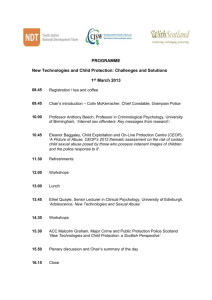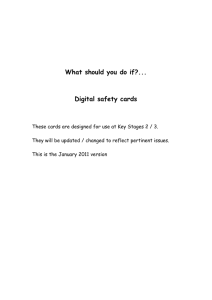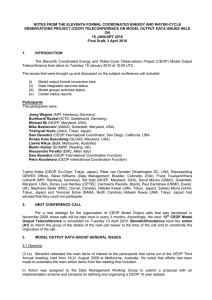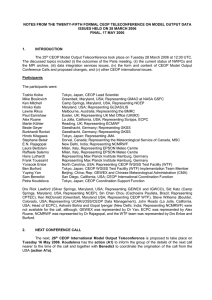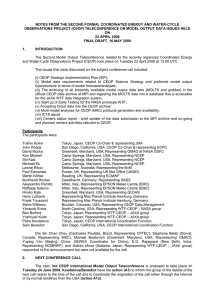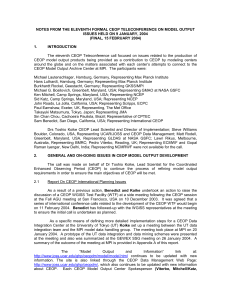NOTES FROM THE SEVENTH FORMAL COORDINATED ENERGY AND WATER-CYCLE
advertisement
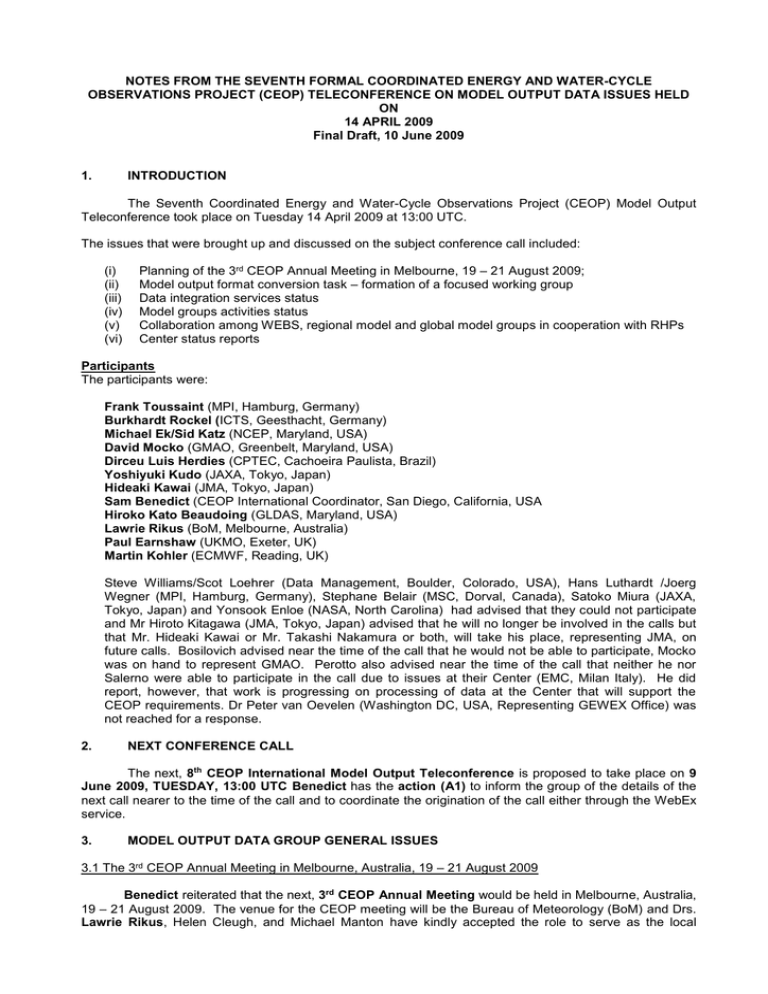
NOTES FROM THE SEVENTH FORMAL COORDINATED ENERGY AND WATER-CYCLE OBSERVATIONS PROJECT (CEOP) TELECONFERENCE ON MODEL OUTPUT DATA ISSUES HELD ON 14 APRIL 2009 Final Draft, 10 June 2009 1. INTRODUCTION The Seventh Coordinated Energy and Water-Cycle Observations Project (CEOP) Model Output Teleconference took place on Tuesday 14 April 2009 at 13:00 UTC. The issues that were brought up and discussed on the subject conference call included: (i) (ii) (iii) (iv) (v) (vi) Planning of the 3rd CEOP Annual Meeting in Melbourne, 19 – 21 August 2009; Model output format conversion task – formation of a focused working group Data integration services status Model groups activities status Collaboration among WEBS, regional model and global model groups in cooperation with RHPs Center status reports Participants The participants were: Frank Toussaint (MPI, Hamburg, Germany) Burkhardt Rockel (ICTS, Geesthacht, Germany) Michael Ek/Sid Katz (NCEP, Maryland, USA) David Mocko (GMAO, Greenbelt, Maryland, USA) Dirceu Luis Herdies (CPTEC, Cachoeira Paulista, Brazil) Yoshiyuki Kudo (JAXA, Tokyo, Japan) Hideaki Kawai (JMA, Tokyo, Japan) Sam Benedict (CEOP International Coordinator, San Diego, California, USA Hiroko Kato Beaudoing (GLDAS, Maryland, USA) Lawrie Rikus (BoM, Melbourne, Australia) Paul Earnshaw (UKMO, Exeter, UK) Martin Kohler (ECMWF, Reading, UK) Steve Williams/Scot Loehrer (Data Management, Boulder, Colorado, USA), Hans Luthardt /Joerg Wegner (MPI, Hamburg, Germany), Stephane Belair (MSC, Dorval, Canada), Satoko Miura (JAXA, Tokyo, Japan) and Yonsook Enloe (NASA, North Carolina) had advised that they could not participate and Mr Hiroto Kitagawa (JMA, Tokyo, Japan) advised that he will no longer be involved in the calls but that Mr. Hideaki Kawai or Mr. Takashi Nakamura or both, will take his place, representing JMA, on future calls. Bosilovich advised near the time of the call that he would not be able to participate, Mocko was on hand to represent GMAO. Perotto also advised near the time of the call that neither he nor Salerno were able to participate in the call due to issues at their Center (EMC, Milan Italy). He did report, however, that work is progressing on processing of data at the Center that will support the CEOP requirements. Dr Peter van Oevelen (Washington DC, USA, Representing GEWEX Office) was not reached for a response. 2. NEXT CONFERENCE CALL The next, 8th CEOP International Model Output Teleconference is proposed to take place on 9 June 2009, TUESDAY, 13:00 UTC Benedict has the action (A1) to inform the group of the details of the next call nearer to the time of the call and to coordinate the origination of the call either through the WebEx service. 3. MODEL OUTPUT DATA GROUP GENERAL ISSUES 3.1 The 3rd CEOP Annual Meeting in Melbourne, Australia, 19 – 21 August 2009 Benedict reiterated that the next, 3rd CEOP Annual Meeting would be held in Melbourne, Australia, 19 – 21 August 2009. The venue for the CEOP meeting will be the Bureau of Meteorology (BoM) and Drs. Lawrie Rikus, Helen Cleugh, and Michael Manton have kindly accepted the role to serve as the local organizing committee. Dr Rikus reported that a request for budget for support of the meeting at the Head Office of the Bureau at Melbourne, had been submitted and was awaiting a response. In addition, local hotel information was being compiled and would be available within the week. 3.2 JAXA CEOS/WGISS Test Facilities (WTF) for CEOP (3.2a) Kudo reported that, during this reporting period, the system hardware has continued to run smoothly at: http://ceop.restec.or.jp/. (3.2b) Kudo further pointed out that even though the new fiscal year had begun and funds were available to maintain the system in its current configuration, there was still no additional funding available for adding any new data or functionality. He explained that in order to include further data on the system a certain steps had to be undertaken by the system administrators that remained beyond the current year’s budget allocation at this time. It means that even though new data is submitted to the MPI (model output) and NCAR (reference site observations), these will not be accessible through the JAXA system until specific menus and links are added to the system. In this context, Koike was identified as continuing to be responsible for action (A2) to negotiate with the JAXA management to improve the budget situation to allow for further development of the JAXA Distributed Data Integration System. (3.2c) Katz reiterated that until certain discrepancies found between the NCEP forecast MOLTS data submitted to the MPI archive and those available on the CEOP/JAXA Distributed Data Integration System were reconciled there was no possibility for implementing any demonstrations of the system capabilities as had been accomplished earlier. It was, therefore, agreed that demonstration of the system would be postponed until the NCEP data on the JAXA system can be corrected and further data and capabilities added. The effort to develop demonstration scripts was therefore suspended awaiting the outcome of action A2 by Koike. (3.2d) - Kudo further reiterated the brief statistic summary on the system use: currently 140 users registered A few users accessed the system each day during the month In most cases, the accessed files included satellite and MOLTS data 3.3 CEOP Model Output format issues and MPI status (3.3a) Katz commented on the MOLTS format conversion subroutine provided by JMA along with the English commentary provided by Koike. The conclusion of Katz assessment was that the subroutine with translation was workable for converting MOLTS data int the NetCDF format as part of the overall effort to homogenize data available through the MPI database. Further comments regarding this matter led the group to conclude that there were still enough technical issues associated with this process and related data and formatting issues to warrant formation of a small working group that would initially focus on a a few technical matters that could benefit from discussion and interaction among various interested Center Representatives. (3.3b) In this context, Katz accepted the action (A3) to assist with the process of activation of this Model Data Format Working Group (FWG). Katz will suggest a few key issues as agenda items for discussion by the Working Group and will also make a suggestion of possible participants in the Group. Previous efforts to activate this group are voided in favor of the plan agreed to at the time of this call. The objective is to more narrowly focus the groups discussions and correspondingly to “limit” the initial membership. Subsequently, Katz completed action A3 as requested. The proposed group will include, at a minimum, the following participants: Sid Katz Martin Kohler Paul Earnshaw Hiroko Kato Alessandro Perotto Stephane Belair Koike/JMA Representative (TBD) Attachment 1 is a draft agenda of topics to be initially addressed by the DFG. Benedict now has action A3a to activate the group and set up an initial conference call of the FWG. (3.3c) In addition, the question of the most suitable gridded output format was raised again during the call. Katz noted that that the MPI suggestion of splitting the GRIB files into a set of files so that each file contain only one model output variable had been discussed with MPI in regard to the NCEP data and found that the suggested format was reconcilable with the data production and handling procedures at their Center. This matter in the context of the NCEP data was, therefore, resolved at the time of the call. The main question had actually come down to the matter of the temporal resolution i.e. whether the gridded data should be at 3 hourly or 6 hourly intervals. The 6 hourly interval was preferred by MPI and was agreed to by NCEP, further resolving the gridded format issue with respect to the preferred MPI standard and the ability of Centers to comply with this standard. The Data Format group will also include the task of the gridded output format on its near future agenda. (3.3 c) Toussaint reported that their team continued the work on CEOP Phase 1 data homogenization and converting into the NetCDF format. All Phase 1, MOLTS data are now on the database in netCDF and ready for download. Kohler noted that ECMWF data including the ERA Interim Reanalysis data had been successfully downloaded from the ECMWF site to MPI. Toussaint verified that the ECMWF data had been downloaded but that while it was available for download by way of FTP it was not yet on the database for direct download. The placement of the ECMWF data on to the database will be done by the time of the next call. (3.3d) Toussaint reiterated that it would be highly desirable to update model output documentation and asked the center representatives for their kind cooperation on this matter. In this context, Benedict asked again the center representatives review the documentation currently in the database associated with their Center’s data and update it as soon as practical (action A4). 3.4 CEOP Global Model Study (http://gmao.gsfc.nasa.gov/research/modeling/validation/ceop.php) Mocko reported GMAO and ERA interim reanalysis data had been added to the MAC ensembles and the new version of the dataset would be soon added on their ftp site (ftp://agdisc.gsfc.nasa.gov/private/ceop/). The review of the manuscript on the “first” MAC study has been completed and accepted for publication as a journal article that will be released soon. A broader “review” type document with more authors is expected in the future that would look at the overall MAC effort and show the results of the second phase of analyses now underway. 3.5 CEOP Inter-Continental Transferability Study/Regional Model Analysis (ICTS) (3.5a) Rockel reminded everyone of the 2nd RCM Workshop on "21st Century Challenges in Regionalscale Climate Modelling" Lund, Sweden, 4-8 May 2009. All relevant information including the program with topics and sessions, as well as information on fees and accomodation can be found on the workshop web site: www.baltex-research.eu/RCM2009. AMMA representatives are going to be at the meeting and may be available to discuss a joint activity with ICTS that could include AMMA regional data and products. Also of interest will be model intercomparisons in monsoon regions being done through the AMIP initiative. (3.5b) Rockel reiterated that the first phase of ICTS focused on building up the data archive had been completed and the group was discussing the next direction of this activity that should be focused on scientific issues. The main focus will be on ensemble simulation and prediction and the implementation strategy is envisioned through close cooperation with numerous on-going projects producing results in this arena. (3.5c) Rockel announced a new effort underway to discover and document the existence of more regional scale high resolution gridded datasets. The CEOP RHP’s will be polled to determine if they have such data and if so where it can be accessed and evaluated for intercomparisons in the ICTS framework. Rockel and Beate Geyer have agreed to advise the group of the progress of this work (Action A5). It was expected that this effort would result in close collaboration among the CEOP Water and Energy Budget Studies (WEBS) working group and the CEOP regional (ICTS) model and global (MAC) model groups in cooperation with RHPs. 4. CURRENT STATUS OF NWPCs 4.1 GLDAS by Hiroko Kato (4.1a) Kato announced that initial problems with the MOLTS conversion routines, that had been provided through JMA, had been found to be associated with the use of a different complier. Once this issue with flags that had been set as a result of the compiler in compatibility had been diagnosed a fix was devised that showed that the code works and that conversion to netCDF can proceed without further incident. Kato has the action (A6) to proceed with the conversion and to run and submit both MOLTS and gridded datasets to MPI. To expedite this process contact will be made with JMA to obtain the subroutine to convert the gridded data into the agreed to format proposed by MPI and generally accepted by the other Centers (see item (3.3b), above) (4.1b) Kato further mentioned that they were in the process of producing new products with a new, more stable forcing dataset and also performing simulations with a new land model that includes groundwater system. Version 3.5 of the CLM model has such a ground water module that would add an interesting component to the output product. Updating from the AVHRR to the CLM version that uses MODIS data is also being looked at. Also, plans include running with a forecast model (GFS) to get land surface simulations up to seven days ahead. Kato agreed to ensure (action A6a) that these new products would be part of the GLDAS contribution to CEOP for Phase 2. 4.2 BoM by Lawrie Rikus (4.2a) Rikus reported that the gridded data conversion results were still being checked for possible errors and that it was still planned that the MOLTS data will be added in during the production mode, which should begin soon. (4.2b) Rickus noted that the MDB workshop that was held recently in Melbourne, was successful and had led to interest from various participants for further interaction with CEOP, particularly in the context of the CEOP Extremes initiative. The hope is that this interest will evolve into the formation of a collaborative International effort between MDB participants and the broader CEOP Extremes community. To assist with this process Benedict and Rickus have the Action (A7) to work with Stewart to add an item to the Agenda for the 3rd CEOP Annual meeting at Melbourne, Australia (19-21 August 2009, that would adequate explore the formation of such a collaborative effort. 4.3 GMAO by David Mocko Mocko reiterated that the GMAO CEOP data had been generated and would be uploaded to the MPI archive in the near future. Firstly, the global output would be sent followed by the MOLTS data. GMAO, which has supported CEOP plans to unify the model output product format across the data providers, is itself, committed to preparing the gridded output as requested by MPI. 4.4 NCEP by Sid Katz Ek had previously reported that NCEP had finalized the MOLTS format for new CEOP phase including all 178 MOLTS points and they would begin to submit the data for the period from 1 June 2008 up to current and then backfill the data from 1 January through 31 May 2008 in this new format. The 2007 data will be most probably submitted in the same format as the data for CEOP Phase 1 (i.e. 41 MOLTS points of Phase 1). Katz confirmed this plan but noted that the parameters of the NCEP data submittal were related to further discussions and application of the conversion and formatting subroutines as noted in items 3.3 above. 4.5 EMC by Alessandro Perotto Perotto was not able to participate in the call but had reiterated in writing that EMC was moving forward with their hardware and model system upgrade before generating the data for CEOP. 4.6 ECMWF by Martin Köhler Köhler expressed his appreciation of the Interim reanalysis data being used in the MAC ensembles and reported that the reanalysis had reached September 2008 and that 2007-2008 data had been provided to MPI. As noted in item 3.3c above it was verified that the ECMWF data had been downloaded as planned. 4.7 CPTEC by Dirceu Luis Herdies As noted following the previous conference call the CEOP Coordination Function had been taken up by Dr. Dirceu Herdies . Dr. Herdies (dirceu.herdies@cptec.inpe.br) is the head of the Modeling and Development Division at CPTEC and is responsible for data assimilation. Dr Herdies joined the call but considered it as an opportunity to monitor the interactions and items of importance without making specific inputs until the time of the next call. 5. OTHER ISSUES 5.1 Meetings (5.1a) The next 3rd CEOP Annual Meeting will be held in Melbourne, Australia, from 19 through 21 August 2009 in conjunction with the GEWEX/iLEAPS science conferences that will take place in Melbourne, 24 – 28 August 2009 (http://www.gewex.org/2009gewex_ileaps_conf.html). Further details of the CEOP meeting will be provided in due course. (5.1b) The 2nd Lund Regional-scale Climate Modeling Workshop will be held in Lund, Sweden from 4 – 8 May 2009 (see the GEWEX calendar page for more information). (5.1c) The International Conference "Mountains: energy, water and food for life. The SHARE project: understanding the impacts of climate change" will be held in Milan, Italy, from 27 – 28 May 2009 (see the CEOP website for further information: http://monsoon.t.u-tokyo.ac.jp/ceop2/meetings.html). (5.1d) The 3rd International AMMA Conference will be held in Ouagadougou, Burkina Faso, from 20 – 24 July 2009 (conference webpage: http://www.amma-international.org/rubrique.php3?id_rubrique=1). (5.1e) The 6th International Scientific Conference on GEWEX and the 2nd iLEAPS Science Conference will be held in Melbourne, Australia, 24 – 28 August 2009. The conference website is available at: http://www.gewex.org/2009gewex_ileaps_conf.html. Abstracts for all sessions can be submitted on-line through the meeting website. The final extended deadline for abstract submission is 15 April 2009. ATTACHMENT 1: DRAFT TALKING POINTS FOR CONSIDERATION BY THE CEOP MODEL DATA FORMAT WORKING GROUP (DFG) AT THE TIME OF THEIR INITIAL CONFERENCE CALL (DATE TBD) Agenda items for the CEOP Model Data Format Working Group (DFG) discussion: Setting ‘standards’ for various items in the MOLTS data, i.e. missing value, file naming convention, descriptive info in the netcdf files. Soil variables that have more than 1 depth value. Should there be a variable for each depth or one variable with multiple depths? Notes about the Netcdf JMA/JAXA Fortran Routines that need clarification. time_diff – comment in source that it is not to be used. make_fldap_ncdf – comments that were not translated at the following line numbers 7-11 output file structure 81-139 access fldap 148-155 file number 196 usage 212 data input 224-226 file name 266 array allocations 283-302 data input options 349 debug info 398 beginning of ft loop 430 debug info write_ncdf_defs -- comments that were not translated at the following line numbers 24-34 variables that are input to this subroutine 453 end of definitions write_ncdf_header 34 compression? convert_element 2-3 intro 79 after on pressure level 110 after test of ielem

